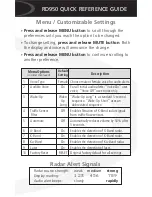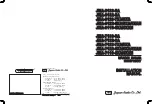
4. Tracked Target (TT) Operation
4-28
4.19 Factors Affecting TT Functions
Sea returns
If the radar anti-clutter control is adjusted properly, there is no serious effect because distant wave clutter, not
eliminated by this control, is filtered out by more than one bang correlation and scan-to-scan matching of data.
Rain and snow
Clutter can be acquired and tracked as targets. Adjust the A/C RAIN control. If it is heavy rain, switch to S-band if
provided, or switch on the interference rejector on the radar. If heavy clutter still exists, switch to manual
acquisition. Accuracy can be affected.
Low clouds
Usually no affect. If necessary, adjust the A/C RAIN control.
Non-synchronous emissions
No effect.
Low gain
Insufficient or low radar receiver gain will result in some targets not being acquired at long distance. TT display will
be missing on one or more targets that could only be visible if the radar sensitivity control (GAIN control) were
increased.
The setting of the correct radar receiver gain is not critical but the target should be on the radar PPI and be clearly
visible and well defined.
Manual acquisition is done if a target is positively displayed more than once. Automatic acquisition is done when
the target is detected 5-7 times continuously. Tracking is achieved when the target is detected five times (not
necessarily continuously) out of 10 scans. If not detected six times out of 10 scans, the target will become a "lost
target." The TT will acquire a radar echo that is present once in every six antenna scans and continue tracking if 1 in
10.
Second trace echoes
When the radar beam is super refracted, strong echoes may be received at such long ranges that they appear on a
different timebase sweep than the transmitted pulse. This gives an incorrect range indication. Second and third trace
echoes can be tracked if they are consistent enough to meet acquisition and tracking criteria but target course and
speed data will be in error.
Blind and shadow sectors
Radar shadow or blind areas caused by obstructions aboard ship, for example, funnels and masts, in the path of the
radar beam can result in reduction of radar beam intensity in that particular direction. This may eliminate the
detection of some targets. The TT system will lose track of targets shortly after they are lost on the radar picture and
if they remain in a blind zone. These targets will however be acquired and tracked when they pass out of the blind
zone and again present normal radar echo. The angular width and bearing of any shadow sector should be
determined for their influence on the radar. In certain cases false echoes in the shadow sector cause the TT system to
acquire, track, and vector them. Shadow sectors should be avoided.
Indirect echoes
A target at close range is usually picked up directly, but it can also be received as reflection from a large, flat
surface. This will result in the radar presenting two or more echoes on the display, each at a different range. The TT
can acquire and track the false echo if it is detected by five consecutive scans. Reduction in radar gain can eliminate
the multiple echoing but care should be taken as range detection also will be reduced.
Radar interference
If interference is extreme due to another radar operating at close range, spiral "dotting" and/or false targets may
appear momentarily. The interference rejector can clear the display.
Summary of Contents for FCR-2107 series
Page 42: ...1 Operational Overview 1 20 This page intentionally left blank...
Page 154: ...5 AIS Operation 5 28 This page intentionally left blank...
Page 255: ...7 Vector Chart Material 7 83 Recommended track defined by two beacons...
Page 256: ...7 Vector Chart Material 7 84 Recommended track defined by a building and a beacon...
Page 257: ...7 Vector Chart Material 7 85 Measurement mile tails tails...
Page 298: ...9 Chart Alerts 9 14 This page intentionally left blank...
Page 322: ...10 Route Planning 10 24 This page intentionally left blank...
Page 368: ...14 Backup Operations 14 6 This page intentionally left blank...
Page 404: ...16 Recording Functions 16 16 This page intentionally left blank...
Page 406: ...17 NAVTEX Messages 17 2 This page intentionally left blank...
Page 416: ...19 Parameters Setup 19 8 This page intentionally left blank...
Page 457: ...Appendix 2 IHO ECDIS Chart 1 AP 5 Nature and Man made features Port features...
Page 458: ...Appendix 2 IHO ECDIS Chart 1 AP 6 Depths Currents etc Seabed Obstructions Pipelines etc...
Page 459: ...Appendix 2 IHO ECDIS Chart 1 AP 7 Traffic routes Special areas...
Page 460: ...Appendix 2 IHO ECDIS Chart 1 AP 8 Aids and Services Buoys and Beacons...
Page 461: ...Appendix 2 IHO ECDIS Chart 1 AP 9 Topmarks Color test diagram...
Page 462: ...Appendix 2 IHO ECDIS Chart 1 AP 10 Mariners navigational symbols...
Page 469: ...Appendix 3 Interpreting S57 Charts AP 17 Fog signals Radars Services...
Page 476: ...Appendix 3 Interpreting S57 Charts AP 24 This page intentionally left blank...
Page 511: ...Appendix 5 Digital Interface AP 59 NRX NAVTEX received data...
Page 544: ...Appendix 6 Parts List and Parts Location AP 92 This page intentionally left blank...
Page 550: ...This page is intentionally left blank...
Page 556: ......
















































